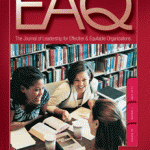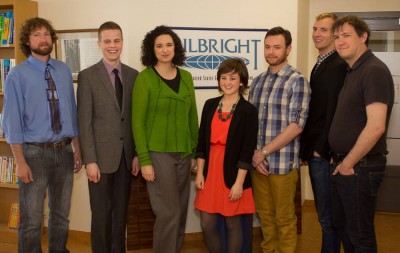 Accolades – below are news and notes from our alumni, faculty, staff, and students. We are proud of all the amazing accomplishments by our Neag family. If you have an accolade to share, we want to hear from you! Please send any news items (and story ideas) to shawn.kornegay@uconn.edu.
Accolades – below are news and notes from our alumni, faculty, staff, and students. We are proud of all the amazing accomplishments by our Neag family. If you have an accolade to share, we want to hear from you! Please send any news items (and story ideas) to shawn.kornegay@uconn.edu.
Students
Jennifer Fiestas, a New London Renzulli Academy student, was one of three students to win an award from Microsoft for Best Invention for Enabling Improved Lifestyle Living or Access by the Disabled. Jennifer invented the “Zee Key” – a piano keyboard with braille notes to aid the visually impaired in learning to play the piano.
Congratulations to the following NGSA Spring 2014 Travel Awards recipients! Once again we had an impressive group of researchers!
Receiving a travel award of $175 are:
William Adams
Beomkyu Choi
Robert Huggins
Jennifer Hyde
Hayley MacDonald
Jessica Martinez
Isabel Park
Jon Rizzo
Sudha Srinivasin
Adam J Sterczala
Michael Sundeen
Nicole Timbrell
Lesley Vandermark
Yan Wei
Huihui Yu
Receiving a travel award of $100 are…
Brent Creighton
Abby Gordon
Zhao Xuelian
Colleen Munoz
UConn Collegiate Chapter of the National Association for Music Education (NAfME) organized and hosted a mini-conference for music education majors in the Gentry building. The event, titled “Behind the Scenes of a Successful Program: a Professional Development Day for Aspiring Music Educators,” involved three music educators presenting on a variety of subjects important to the field of music education.
Secondary pre-service math teachers in IB/M took a field trip to the Museum of Math in NYC. Sharon Heyman, a doctoral student in Curriculum & Instruction, is teaching the secondary Math Methods class while Megan Staples is on sabbatical leave this semester.
Lasan Kromah, a master’s student in Educational Psychology: Cognition, Instruction & Learning Technology, was on the 2014 National Championship Men’s Basketball team.
Scott McCarthy was chosen to be highlighted as an early career professional on the NASP website. He defended his dissertation last month.
Aimee Mwizerwa has been awarded a Margaret McNamara Memorial Fund (MMMF) grant of $16,800 to support her studies leading to a Master’s degree in the TCPCG Program. The MMMF nonprofit public charity was established in 1981 to honor the late Margaret McNamara, who dedicated her life to advocating for education for underserved populations worldwide. The MMMF awards grants to support the education of women from developing countries, who are enrolled in U.S. or Canadian universities and who are committed to work for the benefit of women and children in developing countries.
Alumni
Robert A. Corbo, a lifetime resident of Norwalk died April 29. He was 87. Corbo was born June 23, 1926, he was the son of Grace Mezzo Anderson and stepson of Arvid J. Anderson. He graduated from the Norwalk High, class of 1944, and was a World War II veteran of the United States Army Air Corps. He served from 1945 to 1946 and was discharged with the rank of sergeant. He then graduated from the University of Connecticut, earning a Bachelor’s, Master’s, and a 6th Year Certificate in Business Education. He taught for four years in Colchester at Bacon Academy, six years at Middlesex Junior High in Darien, and 23 years in Greenwich as a teacher and as an administrator. He retired from the Greenwich System in 1985.
Alumni from the Higher Education Student Administration (HESA) program celebrated their inaugural reunion coupled with professional development on May 3.
Neag School of Education Alumni Awards –
The Outstanding Early Career Professional is Jennifer C. Nelson, ’09 BS special education, ’10 MA special education, Special Education Teacher in Ridgefield Public Schools.
The Outstanding Early Career Professional is Jon Welty Peachey, Ph.D., ’09 Ph.D. in sports management, Assistant Professor in the Department of Recreation, Sport, and Tourism at the University of Illinois.
The Outstanding Kinesiology Professional is NiCole R. Keith, Ph.D., ’99 Ph.D. in exercise physiology, Research Scientist at Indiana University Center for Aging Research; Investigator in Regenstrief Institute Incorporated; and Associate Professor, Department of Kinesiology, Indiana University-Purdue University, Indianapolis.
The Outstanding Physical Therapy Professional is Michael L. Reed, PT, DPT, OCS, MTC, ’89 BS in physical therapy, Director of HSS Florida and HSS Spine & Sport, Hospital for Special Surgery, NYC.
Neag School of Education Alumni Awards –
Outstanding School Educator is Sandra M. Bidwell, ’87 MA, ’91 Sixth Year Degree, Reading Recovery Teacher and Reading and Writing Instructional Support Teacher at Staffordville Elementary School.
Outstanding School Administrator is Louis F. DeLoreto, Ph.D., ’00 Sixth Year Degree, ’12 Ph.D., Principal of Edwin O. Smith High School.
The Outstanding School Superintendent is Paul S. Freeman, Ed.D., ’09 Ed.D., Superintendent of Guilford Public Schools.
Outstanding Higher Education Professional is Sally M. Reis, Ph.D., ’81 Ph.D., Vice Provost for Academic Affairs; Board of Trustees Distinguished Professor, UConn.
Outstanding Professional is Felice M. Duffy, Ph.D., ’82 BA, ’85 MA, ’91 Ph.D., Assistant U.S. Attorney at the U.S. Attorney’s Office for the District of Connecticut in New Haven, CT.
Distinguished Alumni of the Year is Dr. Robert C. Pianta, ’77 BS, ’78 MA, dean of the Curry School of Education at the University of Virginia
Aaron Anderson, the director of strategic organizational initiatives for the College of Business at San Francisco State University, is a winner of the 2014 Management Innovation eXchange (MIX) Digital Freedom Challenge for his “Working in Plain View” story. He earned a BS in math from the Neag School in 1987.
Elizabeth Bumgardner is the new principal at North Windham School. She earned a 6th Year Certificate in educational administration from the Neag School in 2012.
Lenny Carlson ’62 (ED), ’63 MS, assistant men’s basketball coach at August State University – Georgia Regents University in Augusta, Ga., was inducted into the New England Basketball Hall of Fame in June 2013 in Worcester, Mass.
Craig Cooke was appointed superintendent of Windsor Public Schools. He had been serving as interim since 2009 and prior to that, he was Windsor School’s assistant superintendent for human resources. He earned a 6th Year Certificate in 2001 and a Ph.D. in 2009.
Kathryn (Scoville) Desrosiers ’01 (ED), music coordinator for Bolton (Conn.) Public Schools, was named the 2013-14 Bolton Public Schools’ Teacher of the Year. A flutist, she also teaches high school concert band, seventh- and eighth-grade concert band, advanced placement music theory, and music technology.
Angelo L. dos Santos ’70 (ED), ’73 JD, a senior judge on the Windham District Superior Court in Connecticut, received in October the Americo S. Ventura Lifetime Achievement Award from the Portuguese Bar Association of Connecticut; the Our Lady of Fatima Appreciation Award; the Outstanding Member Medal from the Portuguese Club of Hartford; official citations from the State of Connecticut Senate, the General Assembly, and the Office of the Connecticut Secretary of State Denise Merrill; and an official statement from the Office of Connecticut Lt. Gov. Nancy Wyman.
David Garvey ’06 Ph.D., director of UConn’s Nonprofit Leadership Program and adjunct professor in UConn’s College of Liberal Arts and Sciences, received the ACCESS Community Action Agency’s 2013 Community Service Award in recognition of his dedication to low-income families
Charles J. Hague, whobegan his career teaching in the Cheshire School System in 1956 where he worked at several elementary schools, recently passed away. Throughout his time with the school system he served as principal of both Chapman and Highland Elementary Schools before his retirement in 1992. He obtained his Master’s and 6th Year Certificate in education from the Neag School of Education.
Beth Hennessy appointed principal at Central Elementary School. Hennessy has been an elementary language arts consultant for the district at Squadron Line School and Central School for seven years. She earned a 6th Year Certificate in curriculum and instruction in 2011.
Marshall Jenkins ’55 (ED), ’72 Ph.D. is the author of Intellectually Persecuted, published in December 2012 by Tate Publishing & Enterprises LLC. The book is available at Barnes & Noble and on amazon.com.
Michael Louis ’05 (ED), ’07 MA, a four-year letterwinner for the UConn men’s tennis team and a six-year assistant coach for the Huskies, is the UConn men’s tennis head coach. He previously served as head coach of the men’s and women’s teams at the University of Hartford.
Michael Luzietti was named principal at Latimer Lane School, Luzietti, who for the past two years has served as principal of New Hartford Elementary and Bakerville Consolidated Schools, worked for the school system as an elementary physical education teacher for 11 years, according to the release. He earned a 6th Year Certificate in educational administration in 2009.
Maria Miranda ’70 was selected as the Eastern Connecticut Chamber of Commerce 64th Annual Citizen of the Year. The veteran advertising executive and UConn graduate was awarded the honor for her contributions not only to the chamber’s growth, but the support she has provided to burgeoning entrepreneurs across the region.
Candace Morell was appointed principal of Mansfield Middle School starting July 1. She previously served as the assistant principal. She has a BS, MA and 6th Year Certificate from the Neag School.
Jan M. Murphy has been hired as the next principal of West Elementary School. She earned a 6th Year Certificate in educational psychology/gifted & talented education in 2002.
Terry A. Osborn, dean and professor of the College of Education at USF Sarasota-Manatee since 2010, was appointed to regional vice chancellor for academic and student affairs. He earned a Ph.D. in curriculum and instruction in 1998.
Margaret “Maggie” (Shafran) Rosa ’64 (ED), an advisor for the Mortar Board National College Senior Honor Society at the University of Vermont, received in August the 2013 Excellence in Advising Award from Mortar Board, presented annually to an advisor who has provided exceptional support to help a Mortar Board chapter achieve its goals.
Kristen (Heiligman) Shanley ’99 (ED), ’00 MA, a seventh-grade language teacher at Dodd Middle School in Cheshire, Conn., was named the 2013-14 Cheshire Public Schools’ Teacher of the Year.
Two graduates of our Ph.D. in Adult Learning Program, Tim Speicher (2010) and Jason Zigmont (2008) were co-authors, along with a third author, of an article titled “Evidence Based Concept Mapping for the Athletic Training Student” which received First Place for the 2014 Athletic Training Education Journal Outstanding Non-Research Manuscript.
Tara (Kozulko) Stritch ’01 is assistant athletic trainer for the U.S. Lacrosse Women’s Senior National Team.
Lois Greene Stone, ‘55, writer and poet, has been syndicated worldwide. Poetry and personal essays have been included in hard & softcover book anthologies. Collections of her personal items/ photos/ memorabilia are in major museums including twelve different divisions of The Smithsonian. Married since 1956 to Dr. Gerald E. Stone, MD, she became a great-grandmother in May 2014. The first of her 15 grandchildren was born on May 8th 27 years ago, and her first great-grandchild was born on May 8th this year.
Denise E. Wilbur ’80 MA is interim vice president for academic affairs at Lincoln University in Pennsylvania. She previously served as vice president for academic affairs and professor education, chief academic officer of the Gwynedd-Valley College in Gwynedd-Valley, Pa.
Kristine Reed Woleck, who previously served as assistant principal at East Elementary School in New Canaan, will return to the school as principal. She earned a 6th Year Certificate in educational administration in 2009.
Faculty
Tenure and Promotion
Promotion to Professor
Jennifer Bruening Educational Leadership
Michael Coyne Educational Psychology
Joseph Madaus Educational Psychology
D. Betsy McCoach Educational Psychology
Promotion to Associate Processor and Tenure
Morgaen Donaldson Educational Leadership
Natalie Olinghouse Educational Psychology
Anjana Bhat Kinesiology
Promotion to Associate Clinical Professor (non-tenure track)
Sandra Billings Curriculum & Instruction
Susan Payne Curriculum & Instruction
Promotion to Assistant Clinical Professor (non-tenure track)
Maryclaire Sullivan-Capetta Kinesiology
Tenure Track Reappointments
Tutita Casa Assistant Professor Curriculum & Instruction
Joseph Cooper Assistant Professor Educational Leadership
Lindsay DiStefano Assistant Professor Kinesiology
Hannah Dostal Assistant Professor Curriculum & Instruction
Shaun Dougherty Assistant Professor Educational Leadership
Jennifer Freeman Assistant Professor Educational Psychology
Rachael Gabriel Assistant Professor Curriculum & Instruction
Richard Gonzales Assistant Professor Educational Leadership
Justin LaFerrier Assistant Professor Kinesiology
Tamika LaSalle Assistant Professor Educational Psychology
Elaine Chuong Hee Lee Assistant Professor Kinesiology
Allison Lombardi Assistant Professor Educational Psychology
Stephanie Mazerolle Assistant Professor Kinesiology
Bianca Montrosse-Moorhead Assistant Professor Educational Psychology
Christopher Rhoads Assistant Professor Educational Psychology
Jennie Weiner Assistant Professor Educational Leadership
Megan Welsh Assistant Professor Educational Psychology
Sarah Woulfin Assistant Professor Educational Leadership
EMPLOYEE ANNIVERSARY RECOGNITION
Sally Reis Renzulli 25 years
Keith Barker 30 years
Jeffrey Crouse 30 years
Mary Anne Doyle 30 years
Joanne Roberg 30 years
Cheryl Bressette 35 years
Scott Brown was named Board of Trustee Distinguished Professor at UConn. This is the highest academic award bestowed to a faculty member.
The Institute for Teaching & Learning, First Year Experience Program & Learning Communities, and the Honors Program are pleased to announce their awardees for their excellence in teaching and advising awards. The recognition dinner was held on April 24th at the Alumni House. The award recipients are:
Outstanding First Year Experience Teaching Awards
Jaci VanHeest, Educational Psychology & Kinesiology
2014-2015 Teaching Fellow Awards
Mary Truxaw, Curriculum & Instruction
2014-2015 – Outstanding Adjunct Awards
Jann Leppien, Educational Psychology
EDLR faculty (Morgaen L. Donaldson, Kimberly LeChasseur, Anjalé D. Welton and Casey D. Cobb) were awarded the Davis Award the best paper from EAQ for 2013. The William J. Davis Award is given annually to the authors of the most outstanding article published in Educational Administration Quarterly (EAQ) during the preceding volume year. The Davis Award was established in 1979 with contributions in honor of the late William J. Davis, former associate director of UCEA and assistant professor at the University of Wisconsin-Madison.
Neag School of Education’s Teacher Prep Program has been accepted into AACTE’s first networked improvement community (NIC). We were one of 10 member institutions selected out of 50 applications. The NIC is aimed at increasing the diversity of our nation’s teacher candidate pool by focusing on recruitment of more Black and Hispanic men into teacher preparation programs. This NIC is one of the programs AACTE has launched as part of their new initiative, The Innovation Exchange.
The Korey Stringer Institute has partnered with USA Football to support its Heads Up Football program that strives to make the game better and safer for youth and high school football players. Also, KSI has completed an agreement for a $300K donation with the NFL Foundation to support KSI’s work.
The Neag School of Education hosted a presentation on “Smarter Balance Assessment System in Connecticut” featuring the executive director of the Smarter Balanced Assessment Consortium, Dr. Joe Willhoft. The new system will replace the CT Master Test and CT Academic Performance Test.
Larry Armstrong was elected president-elect of the American College of Sports Medicine (ACSM).
The MA Dept of Elementary and Secondary Education Department has released a new research brief on the academic impact of career and technical education in Massachusetts. Authored by Shaun Dougherty, the report finds that enrolling in and attending an oversubscribed regional vocational-technical school increases the probability of on-time graduation to nearly 100 percent. That compares to a rate of roughly 60 percent for those students who just barely missed gaining admission and did not attend one of these schools. To read the report, go to http://www.doe.mass.edu/research/reports/2014/03EdLines-CTEimpact.pdf.
Tom Goodkind conducted a workshop entitled “Today’s Mass Media, Personal Technology, and Democratic Core Values” at the 45th annual Northeast Regional Conference on the Social Studies (NERC) on April 8, 2014.
Elizabeth Howard co-directed a grant that resulted in Words in Motion, a cognate-based academic vocabulary curriculum for the middle school grades. Words in Motion is available for free download on the Center for Applied Linguistics (CAL) website. Words in Motion was developed, piloted, and implemented in Connecticut schools as part of the grant EVoCA: Enhancing Vocabulary through Cognate Awareness, funded by the U.S. Department of Education, Institute of Education Sciences. There are three versions of the curriculum: monolingual English, cross-linguistic (primarily in English with explicit connections to Spanish) and bilingual (English/Spanish
Elaine Lee won a Mentorship Award (M Award) from the Connecticut Institute for Clinical and Translational Science (CICATS) at UConn. The period of funding support runs April 1, 2014 – March 31, 2017, in the amount of $50,000 per year. She proposed a three-year initiative to promote STEM education from the earliest stages possible in underrepresented minorities, students from disadvantaged backgrounds, and also in young female students.
Don Leu is a member of the PIRLS 2016 Reading Development Group (RDG) developing the first international assessment of 10-year olds ability to read online and learn new information. He attended meetings of this group in London this month. He also gave a seminar at the University of Jyväskylä in Finland on the assessment of online research and comprehension.
Alan Marcus has a new partnership with the Fairfield Museum. “Behind the Scenes” provides visitors to the Fairfield Museum the chance to learn about the process of putting together Creating Community: Exploring 375 Years of Our Past. Designed by Marcus, Behind the Scenes gives visitors an inside look into how history is presented, making the exhibition design process more transparent by adding a form of “footnotes.” Exhibitor visitors will find 14 “behind the scenes” footnotes. Each footnote has a QR code that visitors can scan with their phone. Marcus, along with his master’s students, designed a new exhibit “The Impact of Weather & Geography on WWII” at the Connecticut State Museum of Natural History. It opened on May 5.
Natalie Olinghouse is a panel contributor to this IES practice guide.
Jim O’Neil will be releasing Men’s Gender Role Conflict: Psychological Costs, Consequences, and an Agenda for Change in October, 2014.
Linda Pescatello won a Core Interest Group (CIG) Award from the Connecticut Institute for Clinical and Translational Science (CICATS) in the amount of $30,000. She used part of the funds to host a full-day workshop on “Thinking About Obesity: Building Science Initiatives at UConn and UConn Health.” The workshop was on April 28.
Yuhang Rong, the assistant dean at the Neag School of Education, was appointed assistant vice provost for global affairs.
Del Siegle was recognized by the Montana AGATE Board with the Friend of AGATE Award. The Montana AGATE Handbook states that the recipient should have “in some way significantly furthered AGATE goals to improve Gifted Education” and should not be a member of AGATE. The Board wholeheartedly believes that Del embodies the essence of furthering the goals of AGATE.
Susanne Wilson was chosen by AERA and Educational Researcher as an Outstanding Reviewer for 2013. She will be publicly recognized at the AERA annual meeting in April.

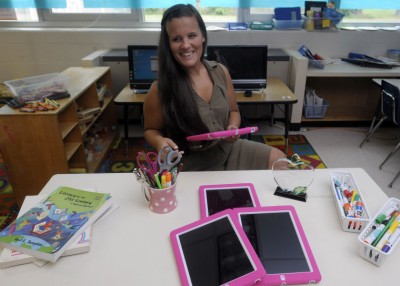
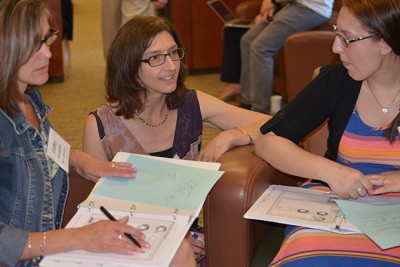


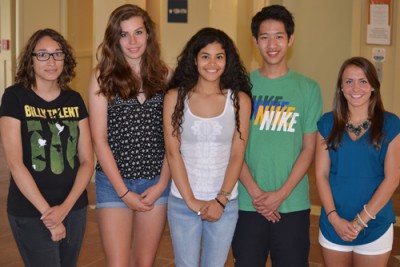

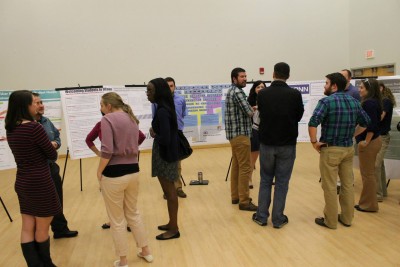
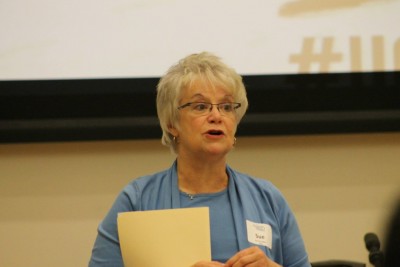
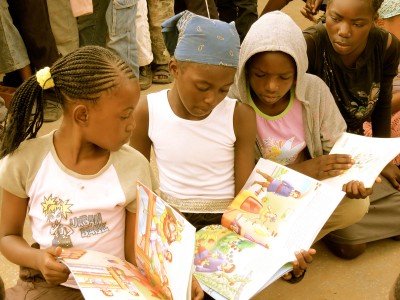
![Melibrarians[1]](https://media.education.uconn.edu/aurora/neag/2014/05/Melibrarians1-299x400.jpg)
![Teacher Workshop[1]](https://media.education.uconn.edu/aurora/neag/2014/05/Teacher-Workshop1-400x300.jpg)

